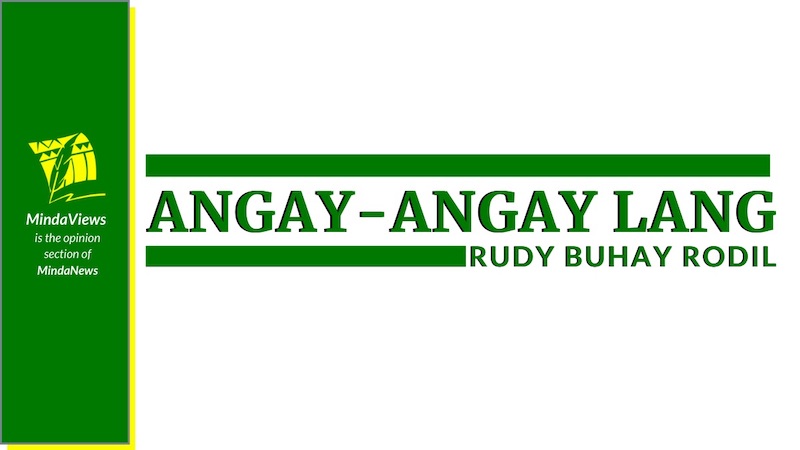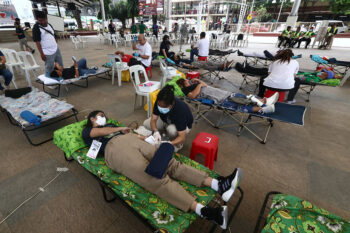 Done in 1992 at Iligan City, published initially as two versions. First as the abbreviated edition published by The Minority Rights Group, London entitled The Lumad and Moro of Mindanaw, July 1993. The Philippine edition carrying the full draft was printed by AFRIM in Davao City 1994. This was later updated in 2003, summarized in an epilogue. This is the third revision, now with an expanded Epilogue.
Done in 1992 at Iligan City, published initially as two versions. First as the abbreviated edition published by The Minority Rights Group, London entitled The Lumad and Moro of Mindanaw, July 1993. The Philippine edition carrying the full draft was printed by AFRIM in Davao City 1994. This was later updated in 2003, summarized in an epilogue. This is the third revision, now with an expanded Epilogue.
Part 1
THE INDIGENOUS PEOPLES IN THE PHILIPPINES: An Overview
The indigenous peoples in the Philippines, now also known officially as indigenous cultural communities (ICC), are said to constitute ten per cent of the estimated total national population of 60 million, per Census 1990. They are more popularly referred to as cultural minorities.
Once the masters of their own lives, now the majority of them are poor and landless. In the old days, many of them lived in the plains. But as a result of population pressures and resettlement programs from among the majority, they have moved to the forest areas. Now, their forests are devastated and their cultures are threatened.
And so, they have learned to fight for survival. Their voices reverberate from north to South, from the Cordillera to the Lumads to the Muslims (or Bangsamoro) of Mindanaw and Sulu.
They demand recognition of their right to self-determination; they demand respect for and protection of their ancestral domains, of their cultures, of their very lives. Within the last twenty years, one group after another of the ICCs have launched their struggles for self-determination, upholding as the most crucial issue their fundamental human right to their ancestral domain.
Interpretation on the meaning of “self-determination” differs. The Moro National Liberation Front consistently takes it to mean independence for the Bangsamoro from the clutches of what they regard as Filipino colonialism, although its leaders agreed to reduce this to regional autonomy in the Tripoli agreement of December 1976.
Advocates in the Cordillera and among the Lumad, however, emphasize their demand for genuine autonomy. But what they all have in common is the conscious realization that their collective happiness must come principally from their own efforts, not from the State.
Who are the Indigenous Cultural Communities?
Created in 1957, the Commission on National Integration (CNI) made an official listing of the National Cultural Minorities (NCM). Note in the Table I below that Luzon and the Visayas have 19 groups, and Mindanaw has 27, which can be further subdivided into 10 Moro and 17 Lumad [for the origin of the name “Lumad”, see Chapter 2]. In the 1960 census, four years after the establishment of the CNI, the NCMs numbered 2,887,526 or approximately ten percent of the national population. The matter of names and number is not a settled issue in the Philippines, which will explain the existence of such names as Kulaman in Mindanaw, which is just another denomination for Manobo in that part of Davao del Sur and two other places in Cotabato called Kulaman, and the addition of more later on. The census itself has never been consistent in its denominations.
Table 1
CNI Official Listing of National Cultural Minorities
|
Luzon/Visayas |
Mindanaw-Sulu |
|
| Lumad | Bangsamoro | |
| 1. Aeta | Ata or Ataas | Badjaw |
| 2. Apayaw or Isneg | Bagobo & Guiangga | Magindanaw |
| 3. Mangyan | Mamanwa | Iranun, Ilanun |
| 4. Bontok | Mangguangan | Kalibugan |
| 5. Dumagat | Mandaya | Maranaw |
| 6. Ifugao | Banwaon | Pullun Mapun |
| 7. Ilongot | Bla-an | Samal |
| 8. Inibaloi, Ibaloi | Bukidnon | Sangil |
| 9. Kalinga | Dulangan | Tausug |
| 10. Kankanai | Kalagan | Yakan |
| 11. Kanuy, Kene | Kulaman | |
| 12. Molbuganon | Manobo | |
| 13. Palawano | Subanen | |
| 14. Batak | Tagabili | |
| 15. Remontado | Tagakaolo | |
| 16. Sulod | Talaandig | |
| 17. Tagbanua | Teduray | |
| 18. Tinggian, or Itneg | ||
| 19. Todag | ||
It is generally known that the Bangsamoro people are made up of 13 ethno-linguistic groups. An explanation is in order why the above list shows only ten. Two of these groups are to be found in Palawan, namely, the Panimusa and the Molbog (Melebugnon or Molbuganon). A third, the Kalagan in Davao del Sur are partly Muslim and partly non-Muslim. The Panimusa, too, are partly Muslim and partly not. Finally, the Badjaw (they prefer Sama Dilaut) are generally not Muslims but because of their identification within the realm of the ancient Sulu sultanate, they have often been regarded as part of the Islamic scene in the Sulu archipelago.
The present majority-minority situation is a product of western colonialism that has been carried over to the present. In the time of Spanish colonialism, it was more an unintended product of colonial order. In the time of the Americans, it was the result both of colonial order and colonial design.
When the Republic of the Philippines assumed sovereign authority, the various administrations not only carried over whatever the Americans had left behind, they also institutionalized the status of cultural minority within Philippine society. In this section we seek to retrace our steps and see how the whole process came about. We start with a broad picture of our current linguistic situation.
Current Linguistic Situation
Inhabiting an archipelago of 7,100 islands which are divided into three broad geographic zones called Luzon, Visayas and Mindanaw, the Philippine population is, according to a linguistic expert, linguistically diverse, distributed, conservatively speaking, into between 100 and 150 languages. However, the expert clarifies, “one should not exaggerate this diversity, since the vast majority of the Filipinos at present are speakers of one of the eight `major languages’ — Tagalog, Cebuano, Hiligaynon, Waray, Bikol, Iloko, Kapampangan, and Pangasinan — while 3 percent of the population comprise the speakers of the rest of these languages — the so-called `minor languages’ — most of whom are pagans or Muslims.” Of the eight, five, namely, Tagalog, Bikol, Iloko, Kapampangan, and Pangasinan inhabit the Luzon area, and three, namely, Cebuano, Hiligaynon and Waray belong to the Visayan region.
The linguistic diversity is not, however, reflected in their skin. Complexion-wise, the majority of the Filipino natives are Malay brown; a much smaller percentage are dark like the Negritos or Aeta of Luzon, the Batak of Palawan and the Mamanwa of Mindanaw.
Linguistic studies have further reduced this diversity with their common conclusion that all Philippine languages “belong to the Austronesian language family”, also known as Malayo-Polynesian. Some of these languages are mutually intelligible, but most are not.
Social Situation at Spanish Contact
Using the situation at the end of the Spanish regime as a frame of reference, the various communities in the Philippine Archipelago may roughly be divided into two broad groupings, those who were colonized, and those who were not.
Those who were colonized generally belong to the barangay communities which composed the eight major groups cited above.
And those who were not may further be subdivided into those who fought and were not subjugated, and those who successfully evaded contact with Spanish forces thereby escaping colonization. Either way they remained free throughout the period of Spanish colonization. The first sub-group consisted of the Muslims of Mindanaw and Sulu and the Igorots of the Cordillera.
The second sub-group were those who are presently known as Tribal Filipinos. By an ironic twist of history it was the unconquered and uncolonized who were later to become the cultural minorities of the twentieth century. But before we go into the broad details of how this happened, let us first look at their social situation at the time of Spanish contact.
We start with the barangays, to be followed by the Muslims, then by those which have been characterized by Dr. William Henry Scott, a well-known scholar of Philippine history, as the warrior societies, the petty plutocracies and the classless societies.
Tomorrow: The Barangay Communities







